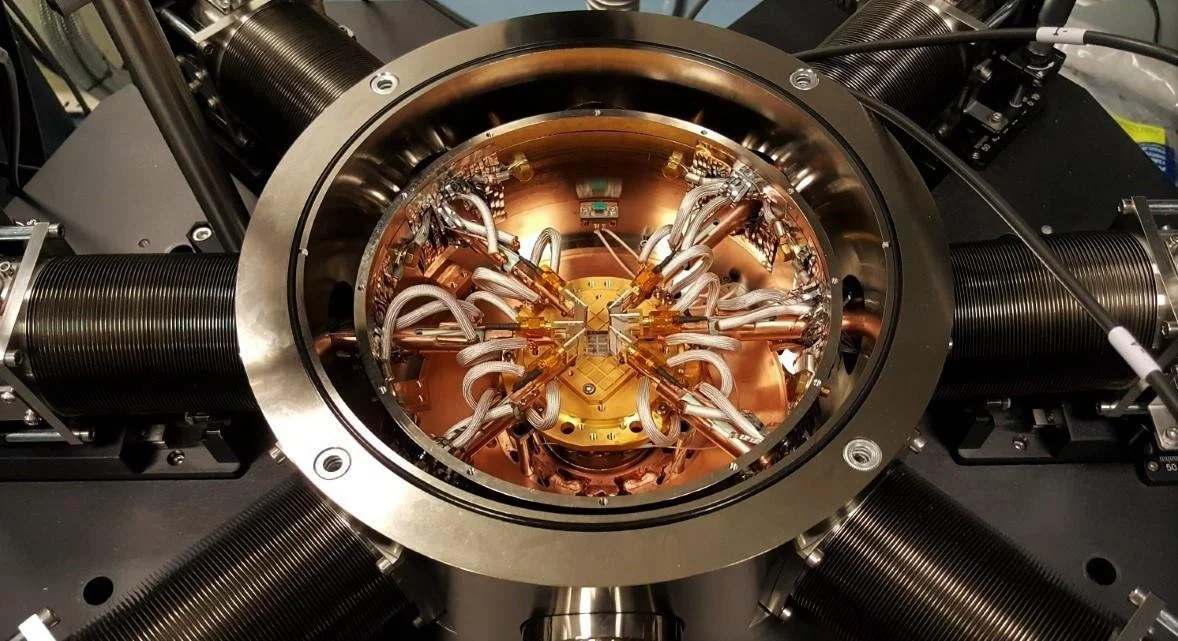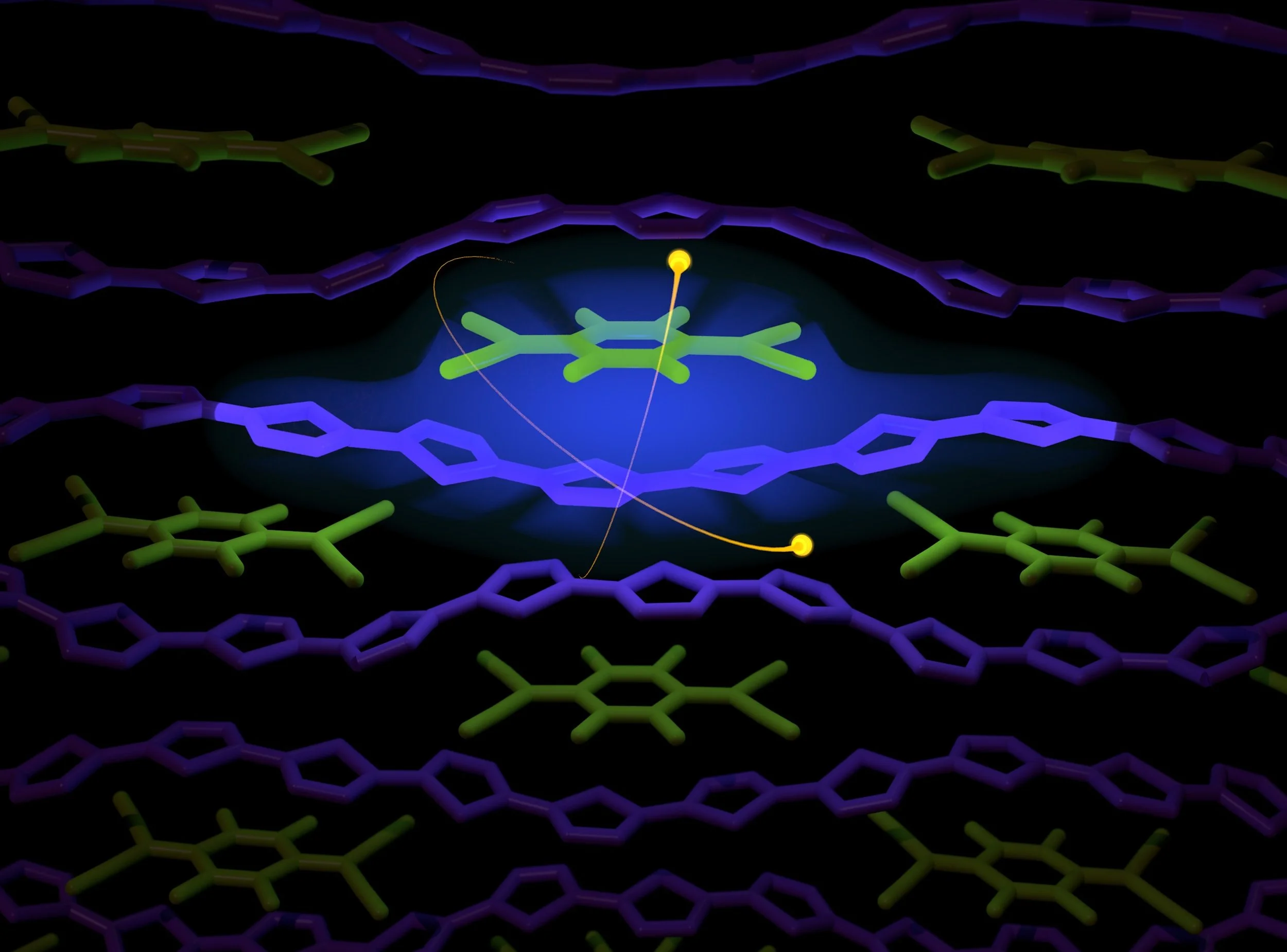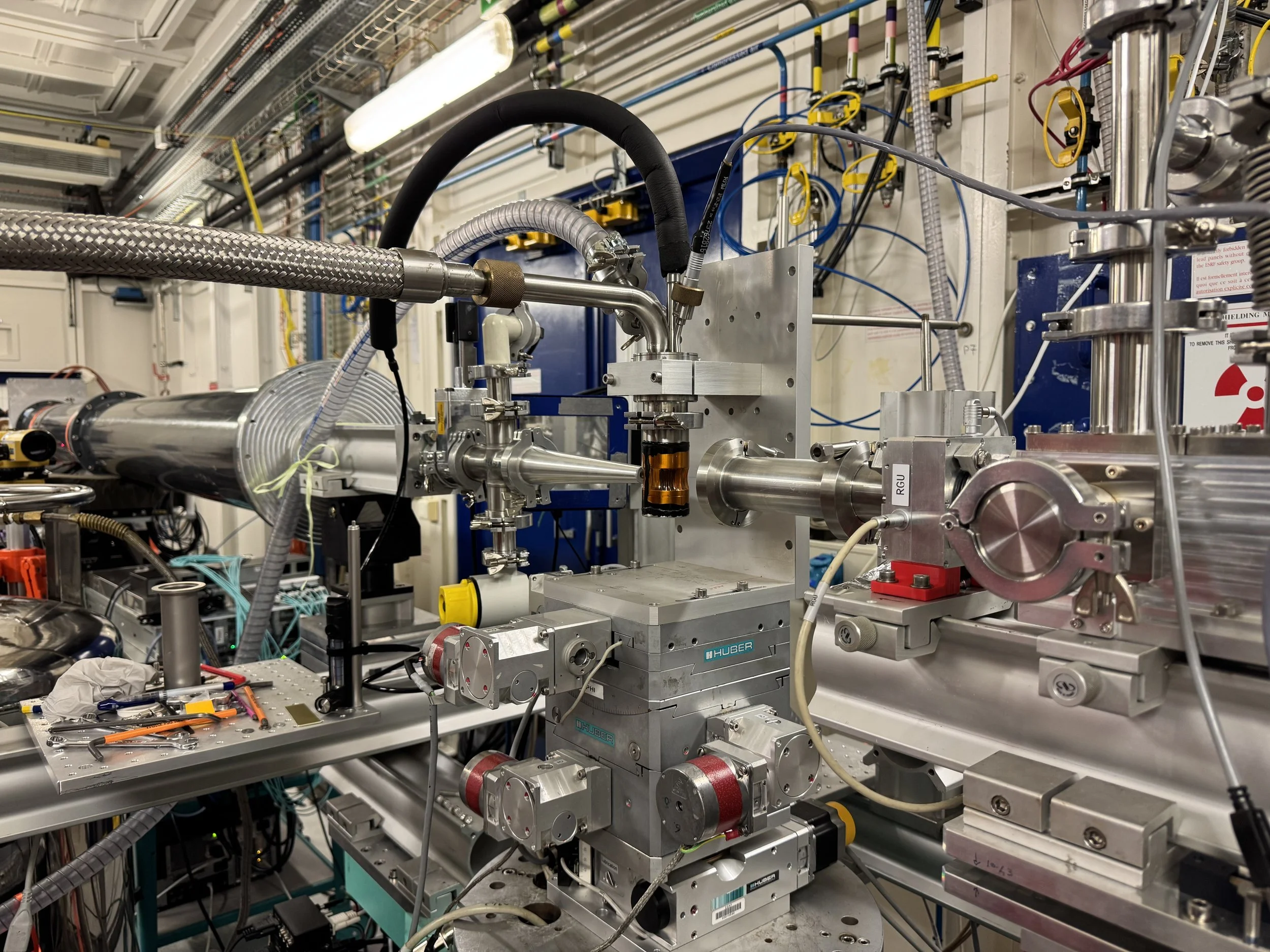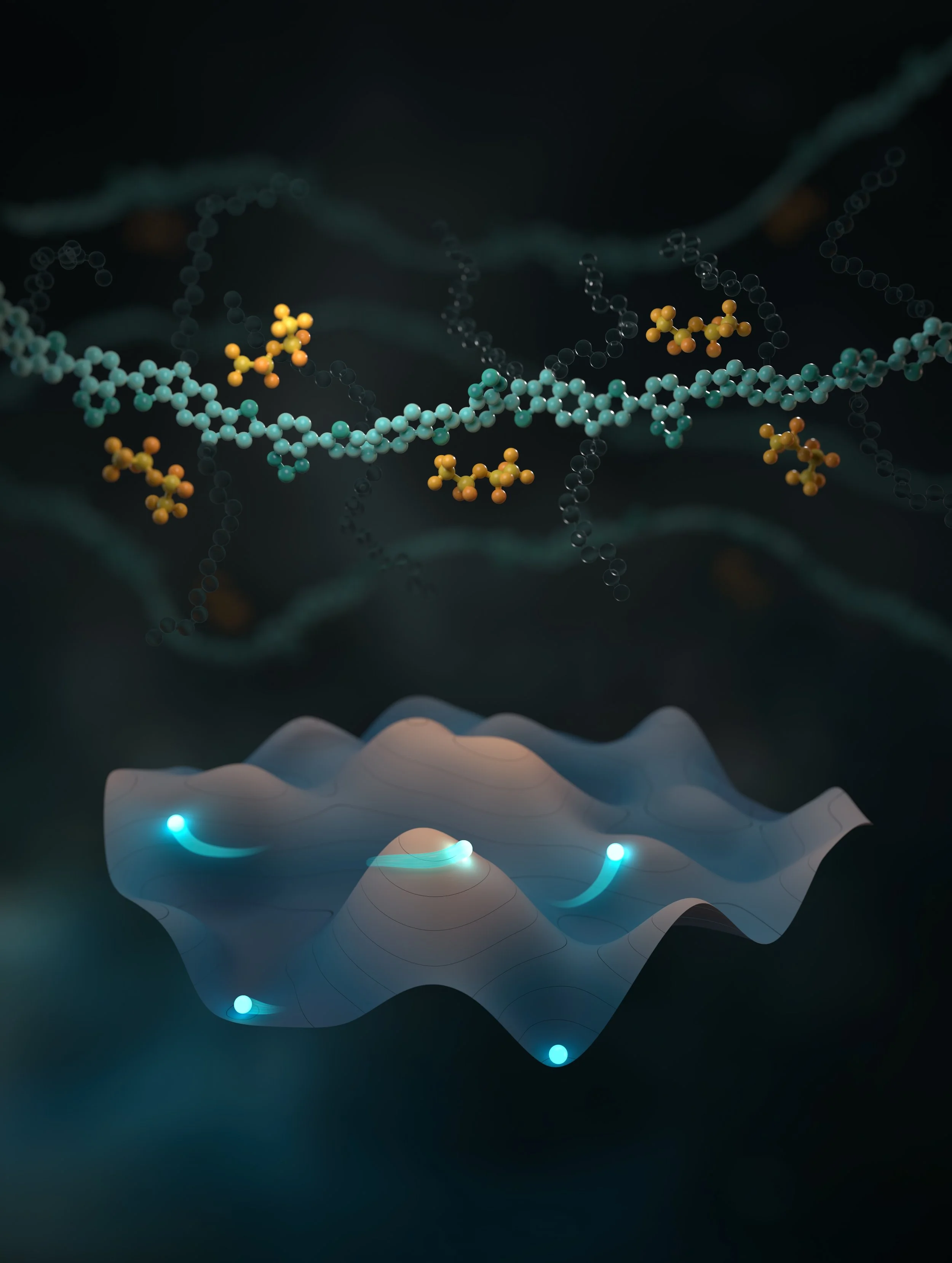
We are an interdisciplinary research group based at the University of Cambridge’s Cavendish Laboratory, studying emerging materials and devices for heat-to-energy conversion and thermal regulation.
Thermoelectrics
Heating and cooling make up the majority of household energy use in most developed countries, yet the basic technologies we use for heating and cooling haven’t evolved significantly in over a century. We study thermoelectric materials—solid state heat engines—that allow us to extract electrical energy from temperature differences, and could find applications in wearable electronics. These devices can also be operated as heat pumps to heat or cool spaces. We are especially interested in low-cost, large-area compatible devices that could be employed as ‘smart insulation’ in buildings to reduce energy use.
Our work focuses largely on the fundamental physics of next-generation thermoelectric materials such as organic mixed conductors (i.e. conjugated polymers). Conjugated polymers have low thermal conductivities and can reach high electrical conductivities, and are already one of the highest-performing room temperature thermoelectric materials. We are exploring several strategies to enhance the efficiency of these devices by taking advantage of recent discoveries in our group, including breakthroughs in our understanding of electronic structure at high doping level, and new techniques for producing stable, highly doped materials.
Representative publications
Non-equilibrium charge transport in conjugated polymers at ultra-high charge densities.
Nature Materials 2024, 23, 1712–1719.
Enhancing the thermoelectric properties of conjugated polymers by suppressing dopant-induced disorder.
Advanced Materials 2024, 36, 2314062.
Enhancing thermoelectric properties of semicrystalline conjugated polymers through controlled tie chain incorporation.
Advanced Materials 2024, 36, 2310480.
Observation of weak counterion size dependence of thermoelectric transport in ion exchange doped conducting polymers across a wide range of conductivities.
Advanced Energy Materials 2023, 13, 2202797.
Design of Experiment Optimization of Aligned Polymer Thermoelectrics Doped by Ion-Exchange
Applied Physics Letters 2021, 119, 111903.
Charge and Ion Transport
Large-area compatible semiconductors, such as organic mixed conductors, metal-organic frameworks, and halide perovskites, are inherently disordered materials with consequently complex charge transport behaviour. These materials are also '“soft” and ionically conductive—i.e. they are mixed conductors. Mixed conductors have a wide variety of applications, ranging from energy storage to bioelectronics, however to optimise these materials for the real-world we require a detailed understanding of their transport physics.
We use a variety of techniques including cryogenic device measurements, optical and magnetic resonance spectroscopies, microstructural measurmements, and microscopy techniques. We also collaborate extensively with theory groups to build a cohesive understanding of charge transport.
Representative publications
Long spin relaxation times of charge carriers in rubrene molecular crystals due to fast transient localization motion
Nature Communications 2025, 16, 7605.
Defect-tolerant electron and defect-sensitive phonon transport in quasi-2D conjugated coordination polymers
Nature Communications 2025, 16, 6628.
Charge Transport and Carrier Polarity Tuning by Electrolyte Gating in Nickel Benzenehexathiol Coordination Nanosheets
Advanced Materials 2025, 37, 2500164.
Non-equilibrium charge transport in conjugated polymers at ultra-high charge densities.
Nature Materials 2024, 23, 1712–1719.
Revealing contributions to conduction from ordered and disordered transport in highly doped conjugated polymers through analysis of temperature-dependent Hall measurements
Physical Review Materials 2023, 7, 034603.
Structural and dynamic disorder, not ionic trapping, controls charge transport in highly doped conducting polymers
Journal of the American Chemical Society 2022, 144, 3005–3019.
Passive Thermal Regulation
To maintain a constant temperature, the Earth must cool itself by re-emitting, on average, the same power as it absorbs from sunlight. This cooling occurs via blackbody radiation in the mid-infrared, in essence establishing radiative heat exchange between the Earth (~300 Kelvin) and the cosmic microwave background (2.7 Kelvin)
Imagine a material that is transparent or reflective to solar wavelengths, but strongly absorbing in the infrared. When placed outside, such a material will not absorb sunlight, but will still emit blackbody radiation. Such radiative cooling materials can achieve sub-ambient temperatures even in full sunlight and produce substantial cooling powers in excess of 100 W/m2, enough to replace air conditioners in well-insulated buildings. Conversely, radiative heating materials that are reflective in the infrared but absorbing at solar wavelengths can be designed to heat more efficiently than even a completely black material. Such materials could dramatically reduce building energy use for heating or cooling, which currently make up the majority of household energy use. We are exploring new approaches to engineering these materials for integration into windows, rooftops, and vehicles.
Representative publications
Coming soon!
Fundamentals of Doping in Solution-Processable Semiconductors
Doping is one of the most fundamental strategies for tuning the properties of any semiconductor—allowing us to tune the carrier density, electrical conductivity, optical properties, and work function. Many emerging device applications, such as organic electrochemical transistors for bioelectronics and thermoelectrics, operate at very high doping levels, however at these concentrations materials often show changes in microstructure and become chemically unstable. We are interested in better understanding the chemical mechanisms underlying these issues, and developing new approaches that can overcome these limitations.
Representative publications
Molecular Doping-Driven Modulation of Domain Charge Transport Elevates Thermoelectric Performance in Polar Polythiophene
ACS Materials Letters 2024, 6, 4351-4359.
Multi-type Electronic Interactions in Precursor Solutions of Molecular Doped P3HT Polymer
Journal of Physical Chemistry B 2024, 128, 3249–3257.
High efficiency ion exchange doping of conducting polymers
Advanced Materials 2021 2102988.
Polymorphism controls the degree of charge transfer in a molecularly doped semiconducting polymer
Materials Horizons 2018, 5, 655–660.
Controlling molecular doping in organic semiconductors
Advanced Materials 2017, 29, 1703063.
Operando Measurement Techniques
We use a wide range of experimental methods in our research, including various spectroscopies (e.g. UV-vis, infrared, Raman, magnetic resonance), electrical and electrochemical measurements, microscopy (e.g. scanning probe, confocal), and structural characterisation techniques (e.g. X-ray diffraction). These measurement are often performed in cryostats to enable measurement at low temperatures, and performed on devices during operation (called operando measurements).
One major focus area currently is synchrotron X-ray based techniques, such as grazing-incidence x-ray scattering. This family of techniques gives us insight into both the static and dynamic structure of material, and can be performed on operating devices, giving insights into how the material changes during the course of operation. These measurements are performed at several synchrotron light sources across the globe, including Diamond Light Source in Oxford, the European Synchrotron Radiation Facility in Grenoble, France (photo), and the Advanced Photon Source in Illinois, USA,
Representative publications
Non-equilibrium charge transport in conjugated polymers at ultra-high charge densities.
Nature Materials 2024, 23, 1712–1719.
Transmission-based Charge Modulation Microscopy on Conjugated Polymer Blend Field-Effect Transistors
The Journal of Chemical Physics2023,158, 034201
Structural and dynamic disorder, not ionic trapping, controls charge transport in highly doped conducting polymers
Journal of the American Chemical Society 2022, 144, 3005–3019.
Super-resolution photothermal patterning in conductive polymers enabled by thermally activated solubility
ACS Nano 2021 15, 7006–7020.
-

Ian Jacobs
Principal Investigator
Ian is a Royal Society University Research Fellow in the Cavendish Laboratory Optoelectronics Group at the University of Cambridge. He holds a B.E. in chemical engineering from The Cooper Union and a Ph.D. in materials science and engineering from the University of California, Davis. Following his PhD, he was a Royal Society Newton International Fellow in the group of Henning Sirringhaus at the University of Cambridge. His research focuses on solid-state devices for heat-energy interconversion, as well as passive thermal management for cars and buildings. In his spare time, he enjoys biking, skiing, scuba diving, brewing beer, and spending time with his son Kai.
-
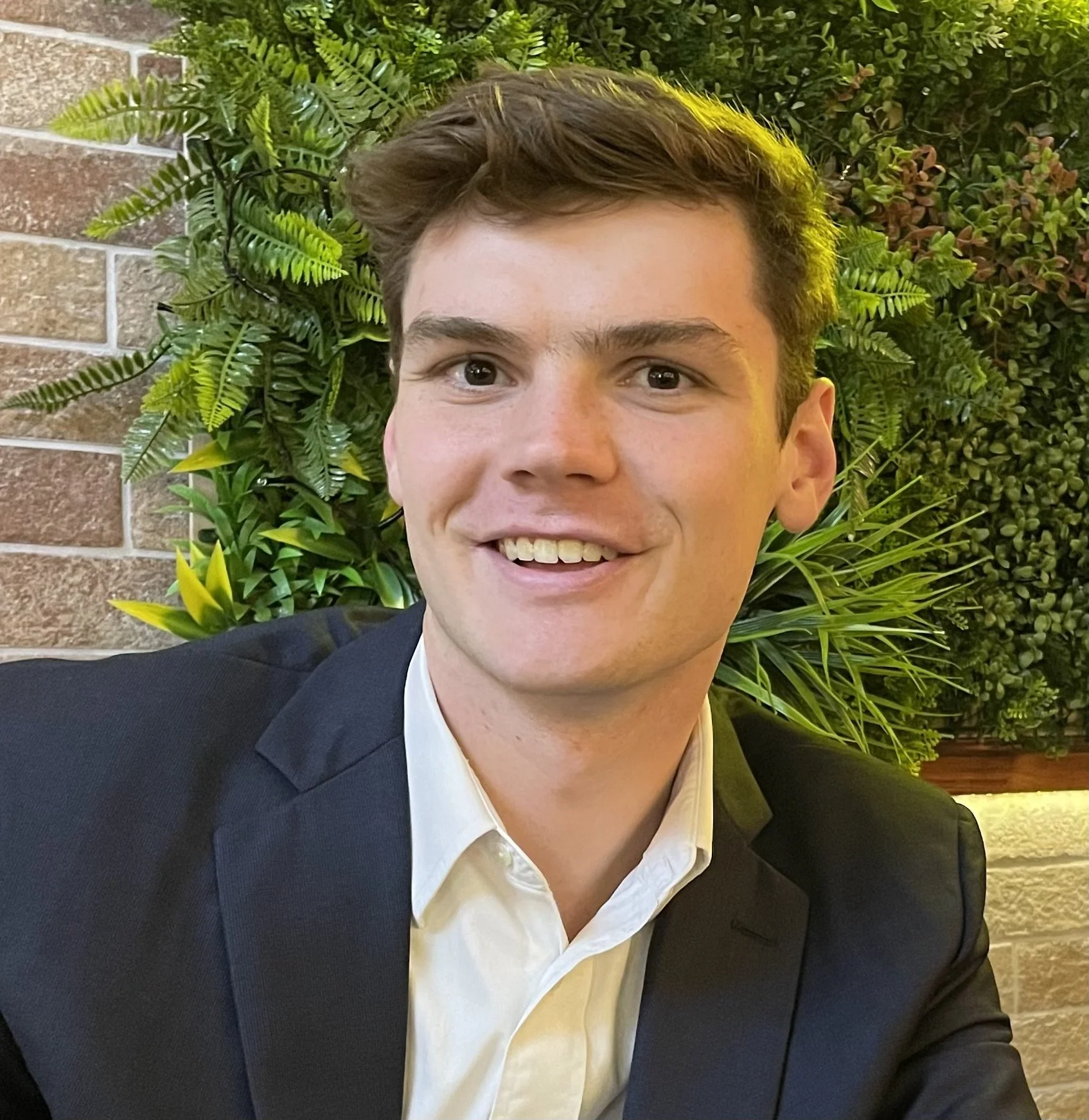
Thomas Marsh
PhD Student
Thomas is currently studying for a PhD in Physics in the Cavendish Laboratory at the University of Cambridge, focusing on radiative cooling materials. Prior to this, he received an MPhil in Physics from the University of Cambridge, and a Bachelors in Physics and Computer Science from Hamilton College, NY. He has previously conducted research at the National Institute of Standards and Technology (NIST), Hamilton College, and the University of Maryland. Outside of the lab, Thomas has competed for Cambridge in rowing — having been part of the victorious Oxford-Cambridge Boat Race crew in 2024. He also enjoys traveling, hiking, and running — he is currently training for the 2025 Amsterdam Marathon.
-

Alumni
Ziyi Fang - MPhil, 2025Isabella Teck - NanoDTC Mini Project 2024
Publications
For up-to-date list, see Google Scholar
2025
Visualizing nanodomain superlattices in halide perovskites giving picosecond quantum transients
Dengyang Guo, Thomas A. Selby, Simon Kahmann, Sebastian Gorgon, Linjie Dai, Terry Chien-Jen Yang, Simon M. Fairclough, Thomas Marsh, Ian Jacobs, Baohu Wu, Renjun Guo, Satyawan Nagane, Tiarnan A. S. Doherty, Kangyu Ji, Jian Mao, Peter Müller-Buschbaum, Henning Sirringhaus, Paul A. Midgley, Samuel D. Stranks
Nature Nanotechnology 2025, in press
Long spin relaxation times of charge carriers in rubrene molecular crystals due to fast transient localization motion
Remington L. Carey†, Xinglong Ren†, Ian E. Jacobs, Jan Elsner, Sam Schott, Elliot Goldberg, Zichen Wang, Jochen Blumberger, Henning Sirringhaus
Nature Communications 2025, 16, 7605.
Defect-tolerant electron and defect-sensitive phonon transport in quasi-2D conjugated coordination polymers
Hio-Ieng Un, Kamil Iwanowski, Jordi Ferrer Orri, Ian E. Jacobs, Naoya Fukui, David Cornil, David Beljonne, Michele Simoncelli, Hiroshi Nishihara, and Henning Sirringhaus
Nature Communications 2025, 16, 6628.
Charge Transport and Carrier Polarity Tuning by Electrolyte Gating in Nickel Benzenehexathiol Coordination Nanosheets
Tian Wu, Xinglong Ren, Zhengkang Qu, Ian E. Jacobs, Lu Zhang, Naoya Fukui, Xin Chen, Hiroshi Nishihara, and Henning Sirringhaus
Advanced Materials 2025, 37, 2500164.
Disorder-Induced Localization With on-Device Tunability in Asymmetric Molecular Semiconductors
Kuakua Lu, Qijing Wang, Zhonglin Zhang, Xinglong Ren, Ian E. Jacobs, Jingsi Qiao, Yi Shi, Yun Li, Henning Sirringhaus
Small Methods 2025, 2500589.
Revealing the Charge Transport Physics in Metallic Coordination Nanosheets by Thermoelectric and Magnetotransport Measurements
Tian Wu, Xinglong Ren, David Cornil, Claudio Quarti, Ian E. Jacobs, Lu Zhang, Naoya Fukui, David Beljonne, Hiroshi Nishihara, Henning Sirringhaus
Science Advances 2025, 11, eadt9196.
2024
Molecular Doping-Driven Modulation of Domain Charge Transport Elevates Thermoelectric Performance in Polar Polythiophene
Kaiqing Lu, Chen Chen, Jingliang Cheng, Ian E. Jacobs, Baiqiao Yue, Pochung Huang, Liang-wen Feng, Yue Lin
ACS Materials Letters 2024, 6, 4351-4359.
Non-equilibrium charge transport in conjugated polymers at ultra-high charge densities
Dionisius H.L. Tjhe,† Xinglong Ren,*† Ian E. Jacobs,*† Gabriele D’Avino,*† Tarig B. E. Mustafa, Thomas G. Marsh, Lu Zhang, Yao Fu, Ahmed E. Mansour, Yuxuan Huang, Wenjin Zhu, Ahmet Hamdi Unal, Vincent Lemaur, Claudio Quarti, Qiao He, Jin-Kyun Lee, Iain McCulloch, Martin Heeney, Norbert Koch, Clare P. Grey, David Beljonne, Simone Fratini, and Henning Sirringhaus*
Nature Materials 2024, 23, 1712–1719.
Press coverage:
Nature Materials: Crossing the Coulomb gap in semiconducting polymers
EurekAlert!: Solving the doping problem: Enhancing performance in Organic Semiconductors
Enhancing the thermoelectric properties of conjugated polymers by suppressing dopant-induced disorder
Suhao Wang†, Wenjin Zhu†, Ian E Jacobs†, William A Wood, Zichen Wang, Suraj Manikandan, Jens Wenzel Andreasen, Hio-Ieng Un, Sarah Ursel, Sébastien Peralta, Shaoliang Guan, Jean-Claude Grivel, Stéphane Longuemart, Henning Sirringhaus
Advanced Materials 2024, 36, 2314062.
Enhancing thermoelectric properties of semicrystalline conjugated polymers through controlled tie chain incorporation
Wenjin Zhu, Xinkai Qiu, Joonatan Laulainen, Hio-leng Un, Xinglong Ren, Mingfei Xiao, Guillaume Freychet, Petr Vacek, Dion Tjhe, Qiao He, William Wood, Zichen Wang, Youcheng Zhang, Zhengkang Qu, Robert Cornell, Jesika Asatryan, Jaime Martin, Martin Heeney, Christopher R. McNeill, Paul Midgley, Ian E. Jacobs*, and Henning Sirringhaus*
Advanced Materials 2024, 36, 2310480.
Electrolyte-gated organic field-effect transistors with high operational stability and lifetime
Dimitrios Simatos, Mark Nikolka, Jérôme Charmet, Leszek J. Spalek, Zenon Toprakcioglu, Ian E. Jacobs, Ivan B. Dimov, Guillaume Schweicher, Mi Jung Lee, Carmen M Fernández-Posada, Duncan J. Howe, Tuuli A. Hakala, Lianne W. Y. Roode, Vincenzo Pecunia, Thomas P. Sharp, Weimin Zhang, Maryam Alsufyani, Iain McCulloch, Tuomas P. J. Knowles, Henning Sirringhaus
SmartMat 2024, 5, e1291.
Multi-type Electronic Interactions in Precursor Solutions of Molecular Doped P3HT Polymer
Vandana Tiwari, Xin Li, Zheng Li, Ian E. Jacobs, Hong-Guang Duan, Henning Sirringhaus, R. J. Dwayne Miller, and Ajay Jha
Journal of Physical Chemistry B 2024, 128, 3249–3257.
2023
Interplay between Side Chain Density and Polymer Alignment: Two Competing Strategies for Enhancing the Thermoelectric Performance of P3HT Analogues
Peter Gilhooly-Finn, Ian E. Jacobs, Olivier Bardagot, Yasser Zaffar, Antoine Lemaire, Shubhradip Guchait, Lu Zhang, Mark Freeley, William Neal, Fanny Richard, Matteo Palma, Natalie Banerji, Henning Sirringhaus, Martin Brinkmann, Christian Nielsen
Chemistry of Materials 2023, 35, 9029–9039.
Effects of processing-induced contamination on organic electronic devices
Dimitrios Simatos†, Ian E. Jacobs†*, Illia Dobryden, Małgorzata Nguyen, Achilleas Savva, Deepak Venkateshvaran, Mark Nikolka, Jérome Charmet, Leszek J. Spalek, Mindaugas Gicevicius, Youcheng Zhang, Guillaume Schweicher, Duncan J. Howe, Sarah Ursel, John Armitage, Ivan B. Dimov, Ulrike Kraft, Weimin Zhang, Maryam Alsufyani, Iain McCulloch, Róisín M. Owens, Per M. Claesson, Tuomas Knowles, Henning Sirringhaus*
Small Methods 2023, 2300476.
Ideal transistor characteristics in a semicrystalline donor-acceptor copolymer with low energetic disorder
Mingfei Xiao, Xinglong Ren, Kangyu Ji, Sein Chung, Xiaoyu Shi, Jie Han, Zefan Yao,
Xudong Tao, Szymon J. Zelewski, Mark Nikolka, Youcheng Zhang, Zhilong Zhang, Zichen Wang, Nathan Jay, Ian Jacobs, Weijing Wu, Han Yu, Yarjan Abdul Samad, Sam Stranks, Boseok Kang, Kilwon Cho, Jin Xie, He Yan, Shangshang Chen, Henning Sirringhaus
Science Advances 2023, 9, eadg8659.
Revealing contributions to conduction from ordered and disordered transport in highly doped conjugated polymers through analysis of temperature-dependent Hall measurements
William A. Wood, Ian Jacobs, Leszek J. Spalek, Yuxuan Huang, Chen Chen, Henning Sirringhaus
Physical Review Materials 2023, 7, 034603.
Observation of weak counterion size dependence of thermoelectric transport in ion exchange doped conducting polymers across a wide range of conductivities
Chen Chen, Ian E. Jacobs*, Keehoon Kang, Yue Lin, Cameron Jellett, Boseok Kang, Seon Baek Lee, Yuxuan Huang, Mohammad Balooch Qarai, Raja Ghosh, Martin Statz, William Wood, Xinglong Ren, Dion Tjhe, Yuanhui Sun, Xiaojian She, Yuanyuan Hu, Lang Jiang, Frank C. Spano, Iain McCulloch, Henning Sirringhaus*
Advanced Energy Materials 2023, 13, 2202797.
Transmission-based Charge Modulation Microscopy on Conjugated Polymer Blend Field-Effect Transistors
Yansheng Zhang, Malgorzata Nguyen, Christoph Schnedermann, Scott Keene, Ian Jacobs, Akshay Rao, and Henning Sirringhaus
The Journal of Chemical Physics 2023, 158, 034201
2022
Single Atom Selenium Substitution-mediated P-type Doping in Polythiophenes towards High-performance Organic Electronics and Thermoelectrics
Chen Chen, Ian E. Jacobs, Cameron Jellett, Xuechen Jiao, James F. Ponder Jr., Boseok Kang, Seon Baek Lee, Lu Zhang, Martin Statz, Yuanhui Sun, Yue Lin, Keehoon Kang, Xiaojian She, Yuanyuan Hu, Tao Zhang, Lang Jiang, Christopher R. McNeill, Iain McCulloch, Henning Sirringhaus
Advanced Electronic Materials 2022, 2200053.
Structural and dynamic disorder, not ionic trapping, controls charge transport in highly doped conducting polymers
Ian E. Jacobs, Gabriele D’Avino, Vincent Lemaur, Yue Lin, Yuxuan Huang, Chen Chen, Thomas Harrelson, William Wood, Leszek J. Spalek, Tarig Mustafa, Christopher A. O’Keefe, Xinglong Ren, Dimitrios Simatos, Dion Tjhe, Martin Statz, Joseph Strzalka, Jin-Kyun Lee, Iain McCulloch, Simone Fratini, David Beljonne, Henning Sirringhaus
Journal of the American Chemical Society 2022, 144, 3005–3019.
Heterometallic Benzenehexathiolato Coordination Nanosheets: Periodic Structure Improves Crystallinity and Electrical Conductivity
Ryojun Toyoda, Naoya Fukui, Dionisius H. L. Tjhe, Ekaterina Selezneva, Hiroaki Maeda, Cédric Bourgès, Choon Meng Tan, Kenji Takada, Yuanhui Sun, Ian Jacobs, Kazuhide Kamiya, Hiroyasu Masunaga, Takao Mori, Sono Sasaki, Henning Sirringhaus, Hiroshi Nishihara
Advanced Materials 2022, 2106204.
2021
Mechanical properties of organic electronic polymers on the nanoscale
V. Panchal, I. Dobryden, U. D. Hangen, D. Simatos, L. J. Spalek, I. E. Jacobs, G. Schweicher, P. M. Claesson, D. Venkateshvaran
Advanced Electronic Materials 2021, 2101019.
Design of Experiment Optimization of Aligned Polymer Thermoelectrics Doped by Ion-Exchange
Yuxuan Huang, Dion Tjhe, Ian E. Jacobs, Xuechen Jiao, Qiao He, Martin Statz, Xinglong Ren, Xinyi Huang, Iain McCulloch, Martin Heeney, Christopher McNeill, Henning Sirringhaus
Applied Physics Letters 2021, 119, 111903.
High efficiency ion exchange doping of conducting polymers
Ian E. Jacobs, Yue Lin, Yuxuan Huang, Xinglong Ren, Dimitrios Simatos, Chen Chen, Dion Tjhe, Martin Statz, Lianglun Lai, Peter A. Finn, William G. Neal, Gabriele D’Avino, Vincent Lemaur, Simone Fratini, David Beljonne, Joseph Strzalka, Christian B. Nielsen, Stephen Barlow, Seth R. Marder, Iain McCulloch, and Henning Sirringhaus
Advanced Materials 2021 2102988.
Charge transport physics of a unique class of rigid-rod conjugated polymers with fused ring conjugated units linked by double carbon-carbon bonds
Mingfei Xiao, Remington L. Carey, Hu Chen, Xuechen Jiao, Vincent Lemaur, Sam Schott, Mark Nikolka, Cameron Jellett, Aditya Sadhanala, Sarah Rogers, Satyaprasad P. Senanayak, Ada Onwubiko, Sanyang Han, Zhilong Zhang, Mojtaba Abdi-Jalebi, Youcheng Zhang, Tudor H. Thomas, Najet Mahmoudi, Lianglun Lai, Ekaterina Selezneva, Xinglong Ren, Malgorzata Nguyen, Qijing Wang, Ian E. Jacobs, Wan Yue, Christopher R. McNeill, Guoming Liu, David Beljonne, Iain McCulloch, Henning Sirringhaus
Science Advances 2021 7, eabe5280
Super-resolution photothermal patterning in conductive polymers enabled by thermally activated solubility
Ian E. Jacobs*, Zaira I. Bedolla Valdez, Brandon T. Rotondo, David J. Bilsky, Ryan Lewis, Alejandra N. Ayala Oviedo, Goktug Gonel, John Armitage, Jun Li, and Adam J. Moulé*
ACS Nano 2021 15, 7006–7020.
2020
Effect of polar side chains on neutral and p-doped polythiophene
Peter A. Finn, Ian E. Jacobs, John Armitage, Ruiheng Wu, Bryan D. Paulsen, Mark Freeley, Matteo Palma, Jonathan Rivnay, Henning Sirringhaus, and Christian B. Nielsen
Journal of Materials Chemistry C 2020, 8, 16216–16223.
2019
Long spin diffusion lengths in doped conjugated polymers due to enhanced exchange coupling
Shu-Jen Wang, Deepak Venkateshvaran, M. R. Mahani, Uday Chopra, Erik R. McNellis, Riccardo Di Pietro, Sam Schott, Angela Wittmann, Guillaume Schweicher, Murat Cubukcu, Keehoon Kang, Remington Carey, Thomas J. Wagner, Janis N. M. Siebrecht, Daniel P. G. H. Wong, Ian E. Jacobs, Razan O. Aboljadayel, Adrian Ionescu, Sergei A. Egorov, Sebastian Mueller, Olga Zadvorna, Piotr Skalski, Cameron Jellett, Mark Little, Adam Marks, Iain McCulloch, Joerg Wunderlich, Jairo Sinova, and Henning Sirringhaus
Nature Electronics 2019, 2, 98–107.
PhD Publications
Effect of processing conditions on additive DISC patterning of P3HT films
Jun Li, Daniella E. Holm, Shravya Guda, Zaira I. Bedolla Valdez, Goktug Gonel, Ian E. Jacobs, Makena A. Dettmann, Jan Saska, Mark Mascal, and Adam J. Moulé
Journal of Materials Chemistry C 2019, 7, 302–313.
Side Chain length Affects Backbone Dynamics in Poly(3-alkylthiophene)s
Pengfei Zhan, Wenlin Zhang, Ian E. Jacobs, David M. Nisson, Adam J. Moulé, Scott T. Milner, Janna Maranas and Enrique D. Gomez
Journal of Polymer Science Part B: Polymer Physics 2018 56, 1193–1202.
Polymorphism controls the degree of charge transfer in a molecularly doped semiconducting polymer
Ian E. Jacobs, Camila Cendra, Thomas F. Harrelson, Zaira I. Bedolla Valdez, Roland Faller, Alberto Salleo, and Adam J. Moulé
Materials Horizons 2018, 5, 655–660.
Put Your Backbone into It: Excited-State Structural Relaxation of PffBT4T-2DT Conducting Polymer in Solution
Varuni Dantanarayana, Jack Fuzell, Dingqi Nai, Ian E. Jacobs, Yan He, Delmar Larsen, and Adam J. Moulé
Journal of Physical Chemistry C 2018, 122, 7020–7026.
Photoinduced degradation from trace diiodooctane in organic photovoltaic films
Ian E. Jacobs, Faustine Wang, Zaira I. Bedolla Valdez, Alejandra N. Ayala Oviedo, David J. Bilsky, and Adam J. Moulé
Journal of Materials Chemistry C 2018, 6, 219–225.
Controlling molecular doping in organic semiconductors
Ian E. Jacobs and Adam J. Moulé
Advanced Materials 2017, 29, 1703063.
Quantitative measurements of the temperature-dependent microscopic and macroscopic dynamics of a molecular dopant in a conjugated polymer
Jun Li, Correy Koshnick, Souleymane O. Diallo, Sophia Ackling, David M. Huang, Ian E. Jacobs, Thomas Harrelson, Kunlun Hong, Guangwu Zhang, Joseph Beckett, Mark Mascal, and Adam J. Moulé
Macromolecules 2017, 50, 5476–5489.
Identifying atomic scale structure in undoped/doped semicrystalline P3HT using inelastic neutron scattering
Thomas F. Harrelson, Yongqiang Cheng, Jun Li, Ian E. Jacobs, Anibal J. Ramirez-Cuesta, Roland Faller, and Adam J. Moulé
Macromolecules 2017, 50, 2424–2435.
Quantitative dedoping of conductive polymers
Ian E. Jacobs, Faustine Wang, Nema Hafezi, Cristina Medina-Plaza, Thomas F. Harrelson, Jun Li, Matthew P. Augustine, Mark Mascal, and Adam J. Moulé
Chemistry of Materials 2017, 29, 832–841.
Direct-write optical patterning of P3HT films beyond the diffraction limit
Ian E. Jacobs, Erik W. Aasen, Derek Nowak, Jun Li, William Morrison, John D. Roehling, Matthew P. Augustine, and Adam J. Moulé
Advanced Materials 2017, 29, 1603221.
Optical Dedoping Mechanism for P3HT:F4TCNQ Mixtures
Jack Fuzell†, Ian E. Jacobs†, Sophia Ackling, Thomas F. Harrelson, David M. Huang, Delmar Larsen, and Adam J. Moulé
Journal of Physical Chemistry Letters 2016, 7, 4297−4303.
Solution aging and degradation of a transparent conducting polymer dispersion
Jun Li, Ian E. Jacobs, Stephan Friedrich, Pieter Stroeve, and Adam J. Moulé
Organic Electronics 2016, 34, 172−178.
Comparison of solution-mixed and sequentially processed P3HT:F4TCNQ films: effect of doping-induced aggregation on film morphology
Ian E. Jacobs, Erik W. Aasen, Julia L. Oliveira, Tayane N. Fonseca, John D. Roehling, Jun Li, Gwangwu Zhang, Matthew P. Augustine, Mark Mascal, and Adam J. Moulé
Journal of Materials Chemistry C 2016, 4, 3454−3466.
The effect of thermal annealing on dopant site choice in conjugated polymers
Jun Li, Christopher W. Rochester, Ian E. Jacobs, Erik W. Aasen, Stephan Friedrich, Pieter Stroeve, and Adam J. Moulé
Organic Electronics 2016, 33, 23−31.
Measurement of small molecular dopant F4TCNQ and C60F36 diffusion in organic bilayer architectures
Jun Li, Chris W. Rochester, Ian E. Jacobs, Stephan Friedrich, Pieter Stroeve, Moritz Riede, and Adam J. Moulé
ACS Applied Materials and Interfaces 2015, 7, 28420−28428.
Introducing solubility control for improved organic p-type dopants
Jun Li, Guangwu Zhang, Daniella M. Holm, Ian E. Jacobs, Bin Yin, Pieter Stroeve, Mark Mascal, and Adam J. Moulé
Chemistry of Materials 2015, 27, 5765−5774.
Reversible optical control of conjugated polymer solubility with sub-micrometer resolution
Ian E. Jacobs, Jun Li, Stephanie L. Burg, David J. Bilsky, Brandon T. Rotondo, Matthew P. Augustine, Pieter Stroeve, and Adam J. Moulé
ACS Nano 2015, 9, 1905−1912.
Mixed interlayers at the interface between PEDOT:PSS and conjugated polymers provide charge transport control
Adam J. Moulé, Min-Cherl Jung, Chris W. Rochester, Wolfgang Tress, Daniela LaGrange, Ian E. Jacobs, Jun Li, Scott A. Mauger, M. Diego Rail, Oliver Lin, David J. Bilsky, Yabing Qi, Pieter Stroeve, Louise A. Berben, and Moritz Riede
Journal of Materials Chemistry C 2015, 3, 2664−2676.
Correlating dilute solvent interactions to morphology and OPV device performance
Lilian Chang, Ian E. Jacobs, Matthew P. Augustine, and Adam J. Moulé,
Organic Electronics 2013, 14, 2431−2443.
